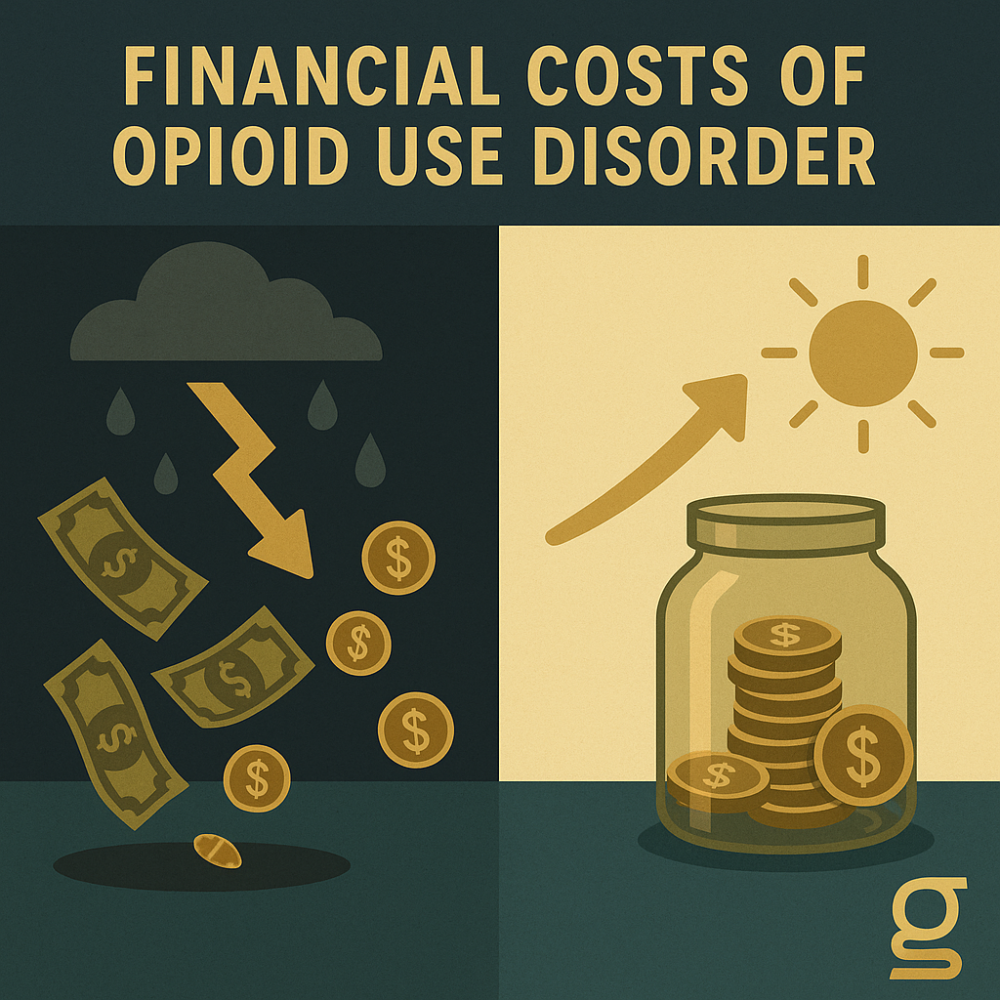Risks of Mixing Gabapentin and Hydrocodone (Vicodin®), Oxycodone (OxyContin®, Percocet®), Oxymorphone (Opana®), Morphine (Kadian®, Avinza®), Codeine, Fentanyl, Hydromorphone, Tapentadol, Methadone, and Heroin.
Navigating the world of medication can be quite daunting, especially when dealing with potentially dangerous interactions like that between Gabapentin and Opioids. Gallus Medical Detox, a leader in providing medically-supervised detox for drugs and alcohol, is here to guide you through the potential dangers of combining these substances and the solutions we offer.
Understanding Gabapentin
Gabapentin is a pharmaceutical medication that was originally developed for epilepsy management. It belongs to the class of drugs known as anticonvulsants or antiepileptics, which work by reducing unusual brain activity that leads to seizures. This makes it a key player in the medical field, especially when it comes to neurological disorders.
However, its application extends beyond epilepsy treatment. It’s also been found to be effective in managing certain types of nerve pain, particularly postherpetic neuralgia (nerve pain following shingles) and peripheral neuropathy (nerve damage from causes such as diabetes or injury).
Gabapentin has a unique structure and function that sets it apart from other anticonvulsants. It’s structurally similar to a neurotransmitter called GABA (gamma-aminobutyric acid), which plays a significant role in suppressing nerve signals in the brain and central nervous system. However, rather than acting directly on GABA receptors, Gabapentin increases the synthesis and synaptic accumulation of GABA, enhancing its overall effect. This can help calm hyperactive nerves, reduce pain, and prevent seizures.
Despite these benefits, Gabapentin use does not come without risks. Like any other medication, it carries the potential for side effects and interactions, especially when misused or combined with other substances like opioids.
Side Effects of Gabapentin
While Gabapentin is often well-tolerated and can provide significant benefits for those suffering from specific conditions, it is crucial to be aware of potential side effects. These can vary in intensity and frequency among different individuals, depending largely on factors such as dosage, duration of use, individual physiology, and the use of other medications.
Common side effects of Gabapentin generally include:
- Dizziness
- drowsiness
- Unsteadiness
These are typically mild and tend to diminish as the body adjusts to the medication. However, it’s essential to be cautious when driving, operating machinery, or performing any other tasks requiring alertness until you know how this medication affects you.
More serious side effects, though less common, can include significant mood or behavioral changes. Some individuals might experience symptoms like:
- anxiety
- depression
- agitation
- hostility
- restlessness
- thoughts of self-harm
In these cases, it is of utmost importance to seek medical attention immediately.
Physical side effects of Gabapentin can also occur. Swelling in the hands, ankles, or feet, unexplained weight gain, and pain in the eyes or visual changes are among the potential physical manifestations. These should not be ignored and should prompt immediate consultation with a healthcare provider.
Although rare, Gabapentin can cause a severe allergic reaction. Symptoms can include rash, itching, or swelling (especially of the face, tongue, or throat), severe dizziness, and difficulty breathing. This requires immediate medical attention.
Misuse of Gabapentin, particularly when combined with opioids, can lead to more severe and potentially fatal side effects such as respiratory depression and increased risk of overdose. This highlights the importance of using Gabapentin responsibly and under the supervision of a healthcare provider.
Awareness of these side effects underscores the need for careful and informed use of Gabapentin. It’s a powerful medication that can offer significant benefits, but it must be used wisely and with a full understanding of potential risks, especially when combined with other substances like opioids.
Exploring Opioids
Opioids, a class of drugs known for their powerful pain-relieving properties, have a long history of use in medicine. They derive their name from opium, a substance extracted from the seed pods of poppy plants. However, today’s opioid medications consist not only of naturally-derived substances but also synthetic and semi-synthetic variants.
Opioids work by binding to opioid receptors located in the brain, spinal cord, and other areas of the body. In doing so, they block pain signals sent from the body through the spinal cord to the brain, thereby reducing the perception of pain. This mechanism makes them particularly useful in managing moderate to severe pain, such as the pain following surgery or pain associated with advanced diseases like cancer.
Apart from their pain-relieving effects, opioids can also produce feelings of relaxation, drowsiness, and euphoria, which can be misused for recreational purposes. The risk of misuse, combined with the body’s propensity to develop tolerance (where higher doses are needed to achieve the same effect) and physical dependence (where the body requires the drug to function normally), leads to a significant risk of addiction.
Common opioids include morphine, codeine, oxycodone (OxyContin, Percocet), and hydrocodone (Vicodin). Fentanyl, a synthetic opioid, is up to 100 times more potent than morphine and has been associated with many cases of opioid overdose. Finally, illegal substances such as heroin also fall under the opioid class.
While opioids play a crucial role in managing severe pain, they must be used responsibly due to their high potential for abuse and addiction. When misused, opioids can lead to harmful side effects, addiction, overdose, and even death. These risks are amplified when opioids are used in combination with other substances, such as Gabapentin. This potentially dangerous interaction, which we will explore in more detail in the following sections, emphasizes the importance of careful, supervised use of both opioids and Gabapentin.
Side Effects of Opioids
Opioids, while highly effective for pain relief, can cause a range of side effects, some of which can be serious and even life-threatening. The severity and occurrence of these side effects can be influenced by various factors, including the type of opioid, dosage, duration of use, individual sensitivity, and whether other medications or substances are being taken concurrently.
Common side effects of opioids typically include:
- drowsiness
- mental fog
- nausea
- constipation
- slowed breathing
These effects usually decrease over time as the body adjusts to the medication, but they can persist or become serious in some cases.
For example, constipation can lead to serious health issues if not properly managed, and extreme drowsiness can affect one’s ability to function daily. If you’re taking opioids and these symptoms persist or become severe, it’s essential to consult with your healthcare provider.
More serious side effects of opioids include opioid-induced respiratory depression (OIRD), a condition where breathing becomes inadequate. This can reduce oxygen supply to the body, causing various physical symptoms and potentially leading to fatal outcomes.
Furthermore, long-term use of opioids can lead to physical dependence and tolerance. Dependence means that the body has become accustomed to the drug’s presence, and withdrawal symptoms will occur if the drug is suddenly stopped or reduced. Tolerance refers to the need for increasing doses to achieve the same pain-relieving effect, which can lead to misuse and opioid addiction.
Finally, opioids can have profound effects on mental health. Long-term use can lead to changes in the brain that result in opioid use disorder (OUD), a type of substance use disorder characterized by loss of control over opioid use, compulsive use, and continued use despite harm or negative consequences.
When opioids are taken with other substances, like Gabapentin, these side effects can be exacerbated, leading to even more severe health risks. Understanding these potential dangers is key to ensuring the safe and responsible use of opioids.
The Effects of Combining Gabapentin and Opioids
The combination of Gabapentin and opioids presents a complex and potentially dangerous interaction. Both are powerful medications, each with its own set of risks, and when taken together, these risks can be amplified. This is mainly due to their combined effects on the central nervous system (CNS) and their potential to induce respiratory depression.
Increased Sedation
At the heart of this interaction is the cumulative sedative effect that both drugs have on the CNS. Gabapentin, by its very nature, is a CNS depressant, reducing abnormal brain activity, which can lead to drowsiness and dizziness. Opioids, on the other hand, not only provide potent pain relief but also produce sedative effects, leading to drowsiness, mental fog, and slowed breathing. When combined, these drugs can significantly increase these sedative effects, leading to heightened drowsiness, confusion, and even loss of consciousness.
Respiratory Depression
Both Gabapentin and opioids can depress respiratory function – they slow breathing rates and decrease oxygen saturation levels. Opioids are particularly notorious for causing opioid-induced respiratory depression, a potentially fatal condition. When combined with Gabapentin, this risk of slowed or stopped breathing is amplified.
Dependence
Moreover, both medications carry a risk of dependence and misuse, especially when used long-term or at high doses. Both physical dependence (where the body requires the drug to function normally) and psychological dependence (where the user feels a compulsion to use the drug) can develop. When these medications are used together, it could potentially accelerate the development of such dependence and increase the risk of substance use disorders.
Research has shown that the concurrent use of Gabapentin and opioids increases the risk of opioid-related death. A study published in the British Journal of Clinical Pharmacology found that patients co-prescribed Gabapentin and opioids had a 60% increased risk of opioid-related death compared to those prescribed opioids alone.
Understanding these risks is crucial for both healthcare providers and patients. Medical professionals must carefully consider the potential risks when prescribing these medications together, and patients need to be informed of these dangers. It is critical to always use these medications under the strict guidance of a healthcare provider, such as the team at Gallus Medical Detox.
Specific Interactions Between Gabapentin and Opioids
Each opioid presents unique risks when combined with Gabapentin due to its specific pharmacological profiles. Let’s delve deeper into these interactions.
Risks of Combining Gabapentin and Hydrocodone (Vicodin®)
Hydrocodone, the active component of Vicodin, has considerable pain-relieving properties. However, when used concurrently with Gabapentin, both drugs, known for their sedative properties, can contribute to enhanced CNS depression. Symptoms can include pronounced drowsiness, confusion, and slowed reflexes. More seriously, this drug combination can lead to significant respiratory depression, resulting in inadequate oxygen reaching vital organs. This increased risk extends to activities like driving or operating machinery, which may lead to accidents due to impaired coordination and cognitive function.
Risks of Combining Gabapentin and Oxycodone (OxyContin®, Percocet®)
Oxycodone, found in medications like OxyContin and Percocet, offers effective relief for moderate to severe pain. However, this potent opioid also induces notable sedation, which can be substantially amplified when combined with Gabapentin. Patients may experience increased drowsiness, blurred vision, and dizziness, which can contribute to accidents and injuries. Additionally, this combination can depress respiratory function, leading to slowed or shallow breathing, which in severe cases may result in hypoxia or even death.
Risks of Combining Gabapentin and Oxymorphone (Opana®)
Oxymorphone, an opioid analgesic in Opana, effectively treats severe pain. However, when used simultaneously with Gabapentin, there is an enhanced risk of CNS depression. This can lead to profound sedation, impaired cognitive function, and slowed respiratory rate. In severe cases, the patient may experience respiratory distress or failure, making it a combination that requires meticulous monitoring by healthcare professionals.
Risks of Combining Gabapentin and Morphine (Kadian®, Avinza®)
Morphine is a natural opioid used in the management of severe pain. When combined with Gabapentin, CNS depression can be heightened, leading to excessive sleepiness, difficulty concentrating, and respiratory depression. This necessitates that the patient be under constant observation, especially during the initial stages of treatment, to avoid adverse effects like respiratory failure.
Risks of Combining Gabapentin and Codeine
Codeine, a less potent opioid, is nonetheless effective for mild to moderate pain. Its combination with Gabapentin can increase the risk of CNS and respiratory depression, leading to symptoms like excessive drowsiness, impaired cognition, and slowed breathing. In severe instances, this can result in hypoxia or a life-threatening overdose, making it necessary for healthcare professionals to be vigilant with dosage adjustments and patient monitoring.
Risks of Combining Gabapentin and Fentanyl
Fentanyl is an extremely potent synthetic opioid often implicated in fatal overdoses. Combined with Gabapentin, there can be profound CNS and respiratory depression, leading to dizziness, extreme sleepiness, and shallow breathing. Given the high potency of Fentanyl, a slight miscalculation in dosage, when combined with Gabapentin, can lead to severe consequences, including fatal overdose. This highlights the need for accurate dosing and stringent patient monitoring.
Risks of Combining Gabapentin and Hydromorphone
Hydromorphone is another potent opioid analgesic, and when used in conjunction with Gabapentin, it can increase CNS depression significantly. This can result in symptoms like profound sedation, slowed cognition, and depressed respiratory function. Severe cases may lead to respiratory distress or failure, requiring vigilant monitoring by healthcare professionals.
Risks of Combining Gabapentin and Tapentadol
Tapentadol, a centrally-acting analgesic, can also interact dangerously with Gabapentin. The resulting increased risk of CNS depression and slowed breathing requires stringent management and observation. This combination can lead to severe drowsiness, impaired cognition, and in the worst cases, respiratory failure.
Risks of Combining Gabapentin and Methadone
Methadone, often used for opioid dependency treatment, can have dangerous interactions with Gabapentin. This combination can lead to excessive sleepiness, slowed reflexes, and impaired cognitive function. Severe respiratory depression can occur, leading to hypoxia and potentially a life-threatening overdose.
Risks of Combining Gabapentin and Heroin
Heroin, an illicit opioid, when used with Gabapentin, can cause severe and potentially lethal health consequences. The combined depressant effects on the CNS can result in sedation, confusion, and significant respiratory depression. The heightened risk of fatal overdose makes this an exceptionally dangerous combination.
Each of these interactions carries distinct risks, highlighting the importance of cautious use under medical supervision. Patients should not adjust dosages or medication regimes without professional medical advice. At Gallus Medical Detox, the team provides expert guidance for safe and effective treatment.
Possible Alternatives to Combining Gabapentin and Opioids
Alternatives to this risky drug combination include other non-opioid pain relievers, certain types of antidepressants, and various therapeutic and lifestyle interventions, all of which can provide significant pain relief for many individuals.
Gallus Medical Detox Can Help
While Gabapentin and opioids may seem like effective pain relievers, combining them carries significant risks. At Gallus Medical Detox, we’re committed to helping you navigate these risks and find a safe and effective path to recovery.
At Gallus Medical Detox, we specialize in providing a safe, effective, and comfortable prescription drug detox experience. We utilize a medically-supervised approach to manage withdrawal symptoms and ensure patients’ safety throughout the detox process.
Choosing Gallus means you’re choosing patient-centered, individualized care. Our compassionate and experienced team is committed to helping you overcome dependencies, providing both physical and emotional support through your journey to recovery.
FAQs
Are Gabapentin and Opioids always dangerous when combined?
Every individual reacts differently to medication combinations. However, the potential risk of severe side effects makes this combination generally ill-advised.
What other medications can I use instead of Gabapentin and Opioids?
There are several alternatives, such as non-opioid pain relievers and certain antidepressants. Always consult with a healthcare provider for personalized advice.
Can lifestyle changes help manage my pain?
Absolutely! Regular exercise, a healthy diet, and techniques such as mindfulness and yoga can significantly help manage pain.
Are all opioids equally risky when combined with Gabapentin?
Different opioids may pose varying levels of risk when combined with Gabapentin. However, a heightened risk is generally present.
How can Gallus Medical Detox help with Gabapentin and opioid dependency?
Gallus Medical Detox provides medically-supervised detoxification services, guiding patients through safe and effective withdrawal management and facilitating a journey toward recovery.
References
- Gomes, T., Juurlink, D. N., Antoniou, T., Mamdani, M. M., Paterson, J. M., & van den Brink, W. (2017). Gabapentin, opioids, and the risk of opioid-related death: A population-based nested case-control study. PLoS Medicine, 14(10), e1002396. https://journals.plos.org/plosmedicine/article?id=10.1371/journal.pmed.1002396
- Goodman, C. W., & Brett, A. S. (2017). Gabapentin and pregabalin for pain — Is increased prescribing a cause for concern? New England Journal of Medicine, 377(5), 411-414. https://www.nejm.org/doi/full/10.1056/NEJMp1704633
- Peckham, A. M., Fairman, K. A., & Sclar, D. A. (2018). All-cause and drug-related medical events associated with overuse of gabapentin and/or opioid medications: a retrospective cohort analysis of a commercially insured US population. Drug Safety, 41(2), 213-228. https://link.springer.com/article/10.1007/s40264-017-0613-5
- Marra, E. M., Mazer-Amirshahi, M., Brooks, G., & van den Anker, J. (2020). Pharmacology of commonly used analgesics and sedatives in children: paracetamol, ibuprofen, morphine, gabapentin, and midazolam. Pediatric Drugs, 22(3), 279-296. https://link.springer.com/article/10.1007/s40272-020-00390-1
- Yaksh, T. L., Wallace, M. S. (2011). Opioids, Analgesia, and Pain Management. In Goodman & Gilman’s: The Pharmacological Basis of Therapeutics. McGraw-Hill. https://accessmedicine.mhmedical.com/content.aspx?bookid=1613§ionid=102157748
- Nelson, L. S., & Juurlink, D. N. (2020). Tramadol and hypoglycemia: One more thing to worry about. JAMA Internal Medicine, 175(2), 194-195. https://jamanetwork.com/journals/jamainternalmedicine/fullarticle/2089207
- Smith, R. V., Havens, J. R., & Walsh, S. L. (2016). Gabapentin misuse, abuse and diversion: a systematic review. Addiction, 111(7), 1160-1174. https://onlinelibrary.wiley.com/doi/full/10.1111/add.13324
- Jones, C. M., Mack, K. A., & Paulozzi, L. J. (2013). Pharmaceutical overdose deaths, United States, 2010. JAMA, 309(7), 657-659. https://jamanetwork.com/journals/jama/fullarticle/1653518
- Centers for Disease Control and Prevention. (2018). Understanding the Epidemic. https://www.cdc.gov/drugoverdose/epidemic/index.html
- World Health Organization. (2020). Information sheet on opioid overdose. https://www.who.int/news-room/fact-sheets/detail/opioid-overdose


 Steve B
Steve B 

 Casey Wilson
Casey Wilson